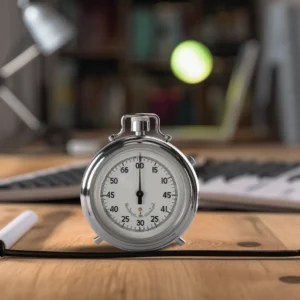In the world of music, precision is paramount. Whether you’re a budding musician or a seasoned virtuoso, the path to mastery often hinges on your ability to perfect timing, accuracy, and technique. This is where the ingenious use of a seconds timer in your music practice routine can work wonders. In this article, we’ll uncover the transformative power of structured music practice, fueled by the ticking seconds on your timer.
The Power of Structured Music Practice
Structured music practice is the secret sauce that separates casual strummers from maestros and shower singers from operatic divas. It’s the deliberate, methodical approach to honing your musical skills, and it’s the key to unlocking your full potential as a musician.
Benefits of Structured Music Practice
- Enhanced Focus: Setting aside dedicated time for focused practice sharpens your concentration. When you know you have a limited window, you’re less likely to be distracted by the allure of checking your phone or wandering thoughts.
- Efficiency: Structured practice optimizes your use of time. Instead of meandering through your repertoire, you target specific areas that need improvement, making your practice sessions far more productive.
- Consistent Progress: Just like a runner builds endurance by systematically increasing their distance, musicians build their skills incrementally. Structured practice ensures that you steadily advance, avoiding plateaus and stagnation.
- Precision Timing: Timing is the lifeblood of music. With structured practice, you can dedicate time to refining your rhythm, ensuring that every note you play or sing lands precisely where it should.
- Improved Accuracy: Whether it’s nailing a complex guitar riff or executing a tricky passage on the piano, structured practice allows you to break down challenging sections and polish them until they gleam with accuracy.
- Mental Discipline: Regular structured practice fosters mental discipline, a valuable trait for musicians. It teaches patience, perseverance, and the art of mastering difficult passages over time.
The essence of structured music practice lies in setting goals, using your practice time efficiently, and incorporating techniques that foster growth. And at the heart of it all is the humble seconds timer, acting as your musical metronome and mentor.
In the next section, we’ll dive into five specific time-saving music practice techniques that leverage the precision of a seconds timer to elevate your musical prowess. These techniques are applicable to a wide range of instruments and musical genres, making them versatile tools for any musician seeking improvement.
5 Time-Saving Music Practice Techniques
- Rhythm and Timing Exercises: Timing is the backbone of music, and it’s crucial to practice rhythm consistently. Set your seconds timer for short intervals, say 30 seconds to start. During this time, focus on a specific rhythmic pattern or metronome marking. Play or sing in strict time, aiming for precision. As you become more comfortable, increase the duration to challenge yourself. Over time, your internal sense of rhythm will become sharper, allowing you to stay in sync with other musicians effortlessly.
- Repetition and Muscle Memory Drills: Many musical passages require muscle memory for fluid execution. Use your timer to guide repetition exercises. For instance, set it for one minute and practice a challenging chord change, scale, or arpeggio repeatedly until the timer rings. Short, focused bursts of repetition help solidify muscle memory, enabling you to perform tricky passages flawlessly.
- Sectional Practice with Precision Timing: Break down complex pieces or songs into manageable sections. Set your timer for the desired practice duration, typically 15-20 minutes. Focus exclusively on one section during this time, aiming for precision and accuracy. When the timer signals, move on to the next section. This approach ensures that you cover all sections systematically and thoroughly, gradually piecing the entire composition together with finesse.
- Tempo Control and Gradual Speed Increases: Mastering tempo is vital for musicians. Choose a musical passage or exercise and set your timer. Start at a comfortable tempo, and play or sing it perfectly within that time frame. As you become more proficient, increase the tempo slightly for the next timed interval. Continue this process, gradually pushing your limits while maintaining accuracy. The timer serves as your guide, ensuring that you make incremental progress.
- Effective Use of Practice Breaks: Practicing for extended periods without breaks can lead to fatigue and decreased focus. Use your timer to schedule short breaks between practice segments. For instance, practice for 20 minutes, then set the timer for a 5-minute break. During this break, stretch, hydrate, and clear your mind. When the timer signals, you’ll return to your practice session refreshed and ready to maintain peak concentration.
By incorporating these time-saving music practice techniques into your routine, you’ll harness the power of structured practice and your trusty seconds timer. Over time, you’ll witness significant improvements in your musical skills, from enhanced timing and accuracy to the ability to tackle challenging passages with confidence. The seconds you invest in structured practice will yield musical dividends that elevate your artistry to new heights.



